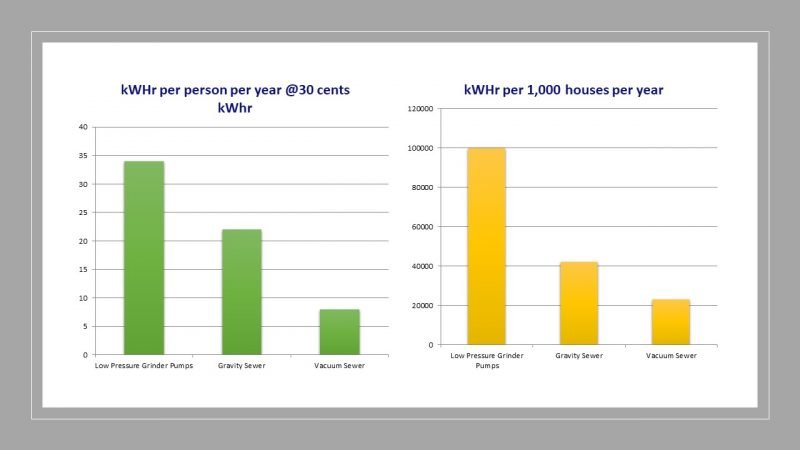Why is a Vacuum Sewer the Best Collection System for the Environment
- 29 June, 2021

Gravity/Low-Pressure/Vacuum – which has the Greenest Credentials
It is very clear that septic tanks and cesspools are a disaster for the environment for a number of reasons. Leaking into waterways, poisoning fish and water birds, creating algae blooms. Affecting the overall health of the community.

Clean waterways are essential
The choice of a gravity sewer, low pressure sewer (grinder pump) or vacuum system is not as clear in many peoples minds. In many communities the health of the community is important, but also, the health of the environment. Many people move to coastal communities because of their love of the natural environment. Maybe the beautiful lake, their favorite beach or special fishing spot. If the area is being affected by sewage spills or sewage smells on a regular basis, closing beaches or impacting local shellfish, how will that affect their property prices and quality of life.
Naturally, the cost of sewerage infrastructure is a critical factor, lets take that as a given, if costs are close to equal, what type of system would be best for the environment?
When clients have done carbon footprint studies in the past, the main areas they look at are in construction, materials and whole of life operational costs which include product replacements and energy use.
Construction
Gravity sewers in flatland tend to be either laid deep in the ground or have multiple pump stations. Deep sewers can mean pipes laid at 5-10 metres (15-30 feet deep trenches), we have seen deeper. In coastal areas this can mean dewatering which can impact the water table. If a contractor is dewatering the trench, that water goes somewhere else. This can impact the overall watertable which can kill off vegetation or impact the aquifer. Whole eco systems can be affected.
Both vacuum and low pressure systems tend to have shallow pipework and construction time is short. That means that equipment at site is much shorter. A project might be installed in a matter of months rather than years. A major carbon impact.

Construction Environmental Impact
Materials with the environment in mind
Coastal area’s gravity sewers need either large diameter pipes or multiple pump stations. One of our earlier costal communities we used one vacuum pump station to replace 17 gravity pump stations. The amount of equipment required in 17 stations would be tremendous.
Low pressure systems it’s even worse. In a community of 1,000 houses, you would need 1,000 pumps and pump chambers. In a vacuum system you would require only 200-250 chambers. Vacuum collection pits are not filled with metal pumps and electrical components. They house vacuum valves which have a 50-year design life with minor parts changes every 10 years. The valves bodies from Flovac have a recycle stamp on them as the PP and GP can be recycled.

Whole of Life Operational Costs
Energy costs are the largest component of operational costs in sewer systems.
In cases such as the one in the section above where one vacuum pump station replaced 17 gravity stations, you can be sure that the energy costs of 17 stations were a lot more than a single vacuum station. That system looked after 1,800 houses. A low pressure pump system would require 1,800 pumps, each one requiring electricity.

Due to the low energy requirements, some vacuum systems are now being powered by solar.
The Bigger Risksfor the environment
Sewerage leaking into the waterways.
In gravity sewers, you could have leaks for months before someone reports a bad smell or something nasty floating in the lake.
Low pressure sewers use a positive pressure and if there is a pipe break sewage can be squirt meters into the air and can be very hard to contain. Contamination of waterways can occur quickly.
Vacuum sewers cannot leak. They operate under a negative pressure and in some projects you will see water and vacuum sewer pipes in the same trench as you cannot get sewage leaking out of the pipe. This video shows how that is possible.
Other benefits
When we installed the vacuum system at the Eco Resort Couran Cove south of the Great Barrier Reef in Australia there were a number of reasons why a vacuum sewer was chosen.
The environmental benefits that they looked at were:
- Ability to handle low flush toilets thus reducing the ultimate treated water disposal problem
- Minimal impact on the landscape during construction with shallow trenches
- Maximum water recovery for reuse in the re-vegetation irrigation system
- Construction route flexibility thus minimizing the damage to vegetation
- Ability to transport grey and black water in the one small bore pipe
- Ability to safely lay all services in the one trench with minimal spacing
- Zero infiltration and exfiltration
- Ability of the system to service the entire site with one centralized pump station
- Ability of the system to service waterfront accommodation and even the sewage and bilge water from yachts

Flovac vacuum systems are referenced as The Green Future of Sewerage. It is easy to see why. What outcome do you want for your community, lets hope its the Green one.
Get our news
Temas
Archives
FLOVAC
Flovac is the world’s leading vacuum sewerage engineering, supplier and operation company.
Primer de Maig 4 Street
08980, Barcelona
Spain

CONTACT US
COPYRIGHT © 2021 FLOVAC - THE GREEN FUTURE OF SEWERAGE


